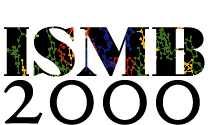1 - A Logic-based Approach for Computational Analysis of Spatially Distributed Biochemical Networks
Andrej Bugrim, Washington University
I present a novel approach for representing data on cell structure, the compartmentalization and localization of molecules in the cell, and an algorithm for using this information in reconstructing signaling pathways and computing their properties. The inference algorithm is based on qualitative ideas of reaction-diffusion systems theory, encoded as production rules for logic-based computations.
2 - Using the RiboWeb System to Compare Ribosomal Models to Experimental Data
Michelle W. Carrillo, Russ B. Altman, Stanford University
The Web-based RiboWeb system contains a knowledge base of experimental ribosomal structural data and computational tools to facilitate modeling and model evaluation. One tool compares models to knowledge base data. We applied it to five 30S subunit models and found patterns in the overall satisfaction of data by the models.
3 - Simulating Biochemical Separations Using Protein Data Bank Files
Paul A. Craig, David Mix, Kristin Cotton, Rochester Institute of Technology
We have developed two computer simulations of separations processes, which extract their data from Protein Data Bank files. These modules are intended as instructional tools for biochemistry students: an ion exchange simulation has been designed for the Windows environment and a JAVA applet models electrophoresis on a Website. http://www.rit.edu/~pac8612/electro/E_Sim.html
4 - Simulation of Genetic Regulatory Systems: A Qualitative Approach
Hidde de Jong, Michel Page, Institut National de Recherche en Informatique et en Automatique (INRIA)
A method for modeling and simulating genetic regulatory systems is presented. The method has been designed to deal with qualitative models, as quantitative information on regulatory interactions is usually missing. Experiments with a Java implementation of the method have shown that regulatory systems of currently up to 18 genes involved in complex feedback loops can be simulated.
5 - Heuristic-based Prediction of Specialized Metabolism
L. B. M. Ellis, J. Liu, M. Vigoroux, C. D. Hershberger, L. P. Wackett, Jeffrey D. Varner, University of Minnesota
We will predict a compound's route of biodegradation by mapping the chemical functional groups of that compound against the capabilities of organism(s) to generate enzymes that operate on these functional groups, based on information in the University of Minnesota Biocatalysis/Biodegradation Database (UM-BBD). http://www.labmed.umn.edu/umbbd/
6 - Predicting Subcellular Localization of Proteins Based on Their N-terminal Amino Acid Sequence
Olof Emanuelsson, Stockholm University; Henrik Nielsen, Søren Brunak, The Technical University of Denmark; Gunnar von Heijne, Stockholm University
TargetP is a neural-network based predictor of protein subcellular location. It discriminates between proteins destined for the mitochondrion, the chloroplast, the secretory pathway, and "other" localizations with a success rate of 85-90%. We estimate that 10% of all Arabidopsis and Homo proteins are mitochondrial, 10% secretory, and, in Arabidopsis, 14% chloroplastic.
7 - A Probabilistic Boolean Approach
to Find Regulatory Networks from Microarray Data
Wataru Fujibuchi, David Landsman, National Library of Medicine
We introduce a probabilistic approach for finding realistic biological regulatory circuits that represent stable Boolean networks from gene expression patterns. This method is applied to the yeast glucose- response and cell-cycle systems. Statistical evaluations show that the reproducibility of known regulatory networks is more significant than randomly drawn networks.
8 - Computer Modeling of Human Erythrocyte using E-cell Simulation System
Yoichi Nakayama, Ayako Kinoshita, Ryo Matsushima, Mitsuhiro Kita, Masaru Tomita, Keio University
We constructed a computer model of the human erythrocyte using E-CELL simulation system. The model has three major metabolic pathways, including glycolysis, the pentose phosphate pathway, and nucleotide metabolism. In this work, we carried out the simulation of enzyme deficiencies such as that of Glucose-6-phosphate dehydrogenase (G6PD).
9 - ProLoc: A New Program that Predicts
Sub-cellular Locations of Proteins
Amit Novik, Einat Hazkani, Erez Levanon, Compugen Ltd.
ProLoc predicts, with high accuracy, the localization of protein among 22 compartments comprising the cell organelles themselves and their membranes. In addition, it divides the membrane proteins into three groups: Type I, Type II, and integral membrane proteins. To achieve high levels of accuracy several different approaches were applied concomitantly.
10 - Computer Simulation of Biomolecular Processes Using Stochastic Process Algebra
Aviv Regev, Tel Aviv University; William Silverman, Naama Barkai, Ehud Shapiro, Weizman Institute of Science
We present a novel approach for quantitative modeling of biochemical networks, at different levels of abstraction. We have developed a new simulation system, Psi, based on the stochastic pi-calculus process algebra. The ability of this well-defined formalism to capture modular structures is illustrated by studying the hysteresis-based model for circadian clocks.
11 - Condensed Representations of
Synergistic Behavior in Biological Regulatory Networks
Armindo Salvador , Michael A. Savageau, The University of Michigan
A recently published formalism performs synergism analysis by quantifying deviations from linear/additive (synergistic) or from power-law/multiplicative (log-synergistic) behavior through second-order differential coefficients. We apply this formalism to a model of a metabolic network and show that it provides for an effective visualization of synergistic and log-synergistic interactions at the systemic level.
12 - Estimation of Metabolic Parameters from Genomic Data
Eberhard O. Voit, Medical University of South Carolina
We have recently demonstrated that microarray data, quantifying gene expression profiles after a stimulus, can be analyzed and explained with metabolic pathway models designed within Biochemical Systems Theory (BST). The poster addresses the opposite direction: values of kinetic parameters can be deduced from, or at least constrained by, genomic information.
13 - Integrative Modeling of Mitochondrial Metabolism Using E-Cell System
Katsuyuki Yugi, Masaru Tomita, Keio University
We are in the process of constructing a kinetic model of mitochondrial metabolism using E-CELL System, a generic simulation environment for cellular simulation based on multiple ordinary differential equations. Our eventual goal is to apply the model to pathological analyses of mitochondrial diseases.


